Comprehensive Analysis of Nursing Research on COPD Exacerbations
VerifiedAdded on 2021/05/31
|9
|2498
|51
Homework Assignment
AI Summary
This assignment provides an analysis of a qualitative nursing research study focusing on chronic obstructive pulmonary disease (COPD) exacerbations. The study aimed to explore patients' understanding and management of COPD exacerbations through interview-based data collection. The research design involved semi-structured interviews with 44 participants, examining their knowledge, experiences, and self-management strategies related to COPD. Key findings revealed that patients could distinguish between 'bad days' and exacerbations, and identify both visible and invisible symptoms. The analysis included grounded theory and constant comparative methods, with data analyzed using NVIVO 10. The study's rigor was enhanced through coding, memo-writing, and discussion among experienced researchers. The study's findings suggest that patient education can improve early identification and self-management of COPD, potentially leading to better health outcomes. This study offers insights into the importance of patient education and self-management in COPD care and suggests that its findings could be transferred to other long-term health conditions.

Evidence Based Nursing Research
1
1
Paraphrase This Document
Need a fresh take? Get an instant paraphrase of this document with our AI Paraphraser
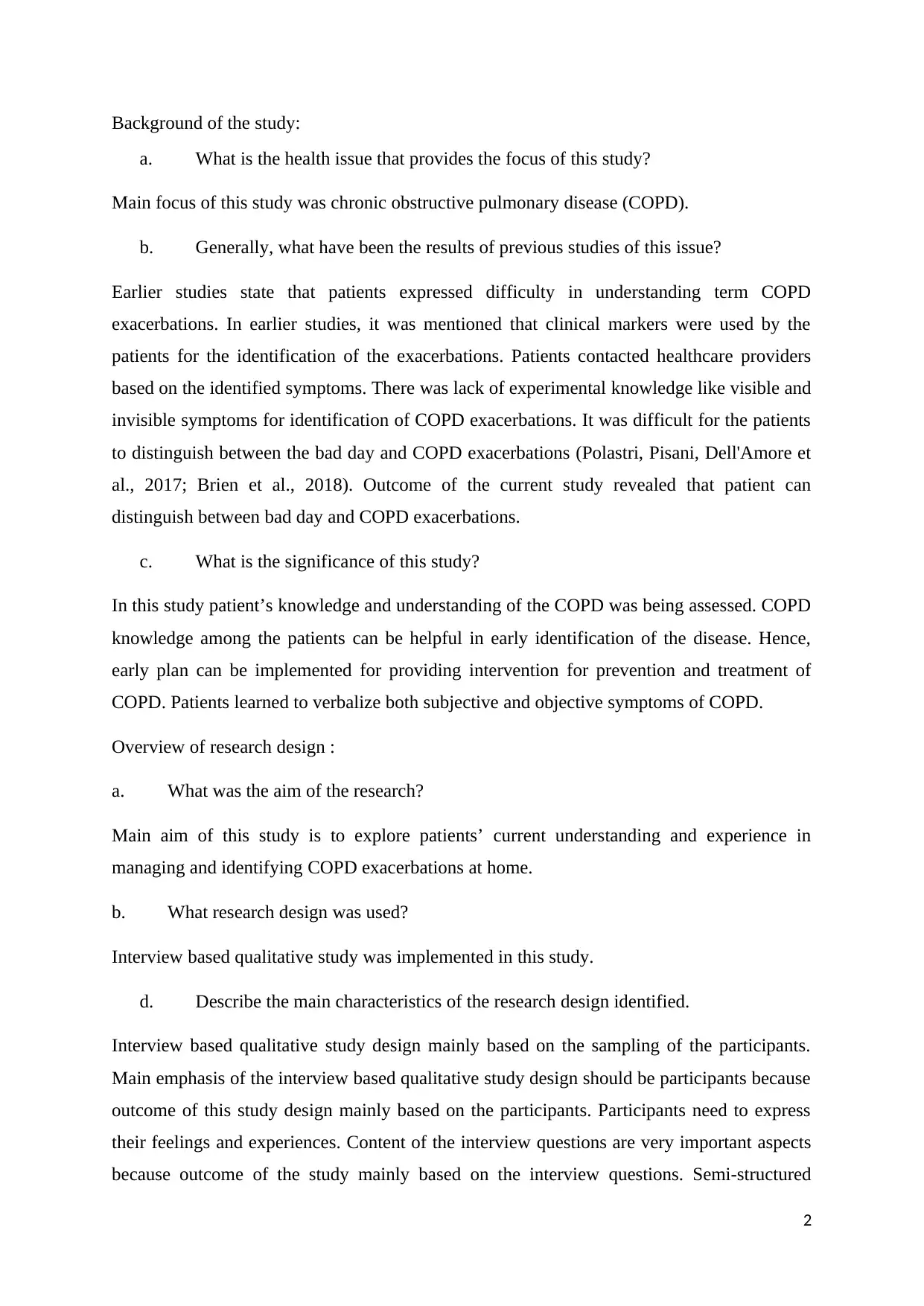
Background of the study:
a. What is the health issue that provides the focus of this study?
Main focus of this study was chronic obstructive pulmonary disease (COPD).
b. Generally, what have been the results of previous studies of this issue?
Earlier studies state that patients expressed difficulty in understanding term COPD
exacerbations. In earlier studies, it was mentioned that clinical markers were used by the
patients for the identification of the exacerbations. Patients contacted healthcare providers
based on the identified symptoms. There was lack of experimental knowledge like visible and
invisible symptoms for identification of COPD exacerbations. It was difficult for the patients
to distinguish between the bad day and COPD exacerbations (Polastri, Pisani, Dell'Amore et
al., 2017; Brien et al., 2018). Outcome of the current study revealed that patient can
distinguish between bad day and COPD exacerbations.
c. What is the significance of this study?
In this study patient’s knowledge and understanding of the COPD was being assessed. COPD
knowledge among the patients can be helpful in early identification of the disease. Hence,
early plan can be implemented for providing intervention for prevention and treatment of
COPD. Patients learned to verbalize both subjective and objective symptoms of COPD.
Overview of research design :
a. What was the aim of the research?
Main aim of this study is to explore patients’ current understanding and experience in
managing and identifying COPD exacerbations at home.
b. What research design was used?
Interview based qualitative study was implemented in this study.
d. Describe the main characteristics of the research design identified.
Interview based qualitative study design mainly based on the sampling of the participants.
Main emphasis of the interview based qualitative study design should be participants because
outcome of this study design mainly based on the participants. Participants need to express
their feelings and experiences. Content of the interview questions are very important aspects
because outcome of the study mainly based on the interview questions. Semi-structured
2
a. What is the health issue that provides the focus of this study?
Main focus of this study was chronic obstructive pulmonary disease (COPD).
b. Generally, what have been the results of previous studies of this issue?
Earlier studies state that patients expressed difficulty in understanding term COPD
exacerbations. In earlier studies, it was mentioned that clinical markers were used by the
patients for the identification of the exacerbations. Patients contacted healthcare providers
based on the identified symptoms. There was lack of experimental knowledge like visible and
invisible symptoms for identification of COPD exacerbations. It was difficult for the patients
to distinguish between the bad day and COPD exacerbations (Polastri, Pisani, Dell'Amore et
al., 2017; Brien et al., 2018). Outcome of the current study revealed that patient can
distinguish between bad day and COPD exacerbations.
c. What is the significance of this study?
In this study patient’s knowledge and understanding of the COPD was being assessed. COPD
knowledge among the patients can be helpful in early identification of the disease. Hence,
early plan can be implemented for providing intervention for prevention and treatment of
COPD. Patients learned to verbalize both subjective and objective symptoms of COPD.
Overview of research design :
a. What was the aim of the research?
Main aim of this study is to explore patients’ current understanding and experience in
managing and identifying COPD exacerbations at home.
b. What research design was used?
Interview based qualitative study was implemented in this study.
d. Describe the main characteristics of the research design identified.
Interview based qualitative study design mainly based on the sampling of the participants.
Main emphasis of the interview based qualitative study design should be participants because
outcome of this study design mainly based on the participants. Participants need to express
their feelings and experiences. Content of the interview questions are very important aspects
because outcome of the study mainly based on the interview questions. Semi-structured
2
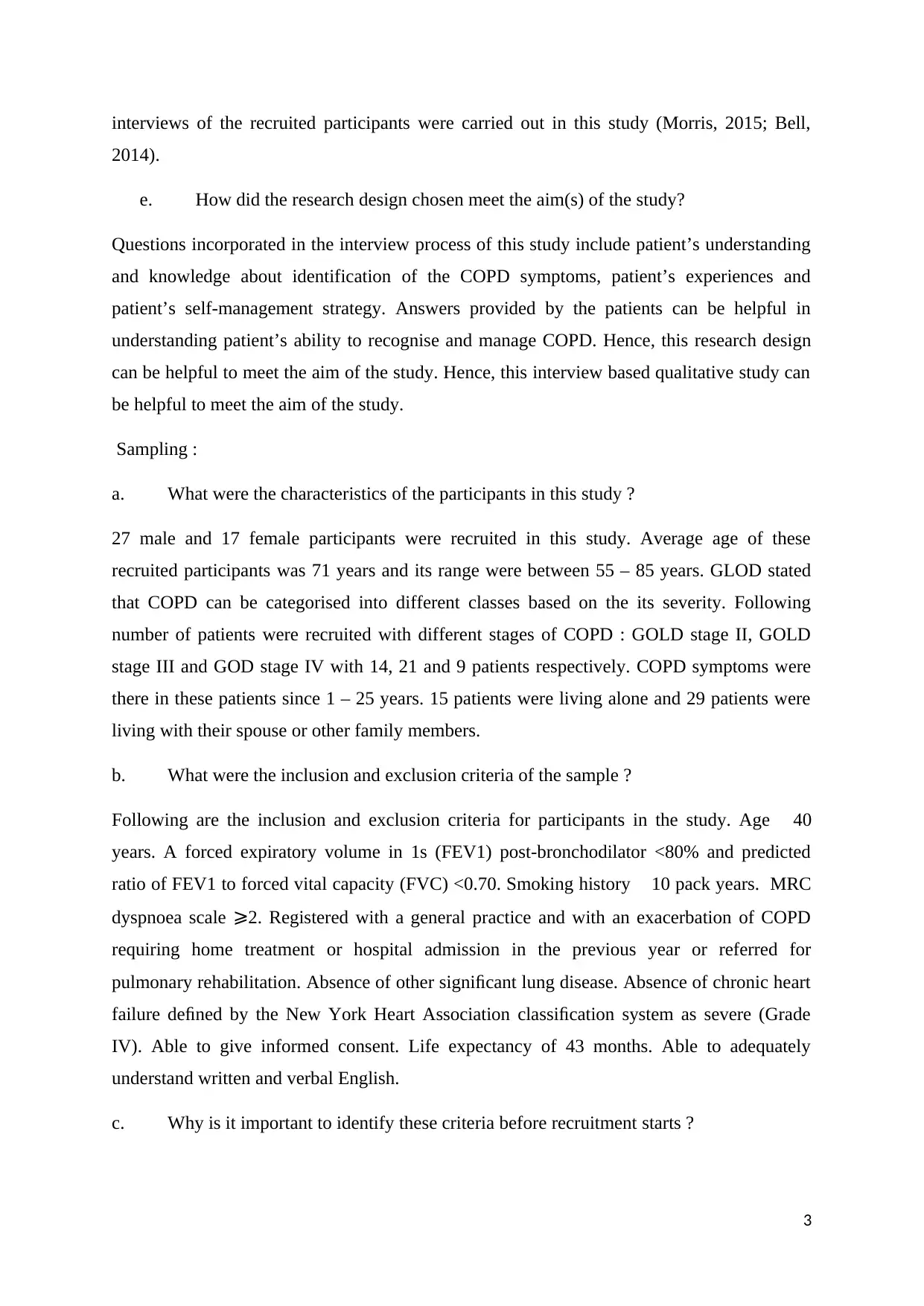
interviews of the recruited participants were carried out in this study (Morris, 2015; Bell,
2014).
e. How did the research design chosen meet the aim(s) of the study?
Questions incorporated in the interview process of this study include patient’s understanding
and knowledge about identification of the COPD symptoms, patient’s experiences and
patient’s self-management strategy. Answers provided by the patients can be helpful in
understanding patient’s ability to recognise and manage COPD. Hence, this research design
can be helpful to meet the aim of the study. Hence, this interview based qualitative study can
be helpful to meet the aim of the study.
Sampling :
a. What were the characteristics of the participants in this study ?
27 male and 17 female participants were recruited in this study. Average age of these
recruited participants was 71 years and its range were between 55 – 85 years. GLOD stated
that COPD can be categorised into different classes based on the its severity. Following
number of patients were recruited with different stages of COPD : GOLD stage II, GOLD
stage III and GOD stage IV with 14, 21 and 9 patients respectively. COPD symptoms were
there in these patients since 1 – 25 years. 15 patients were living alone and 29 patients were
living with their spouse or other family members.
b. What were the inclusion and exclusion criteria of the sample ?
Following are the inclusion and exclusion criteria for participants in the study. Age 40
years. A forced expiratory volume in 1s (FEV1) post-bronchodilator ˂80% and predicted
ratio of FEV1 to forced vital capacity (FVC) ˂0.70. Smoking history 10 pack years. MRC
dyspnoea scale ⩾2. Registered with a general practice and with an exacerbation of COPD
requiring home treatment or hospital admission in the previous year or referred for
pulmonary rehabilitation. Absence of other significant lung disease. Absence of chronic heart
failure defined by the New York Heart Association classification system as severe (Grade
IV). Able to give informed consent. Life expectancy of 43 months. Able to adequately
understand written and verbal English.
c. Why is it important to identify these criteria before recruitment starts ?
3
2014).
e. How did the research design chosen meet the aim(s) of the study?
Questions incorporated in the interview process of this study include patient’s understanding
and knowledge about identification of the COPD symptoms, patient’s experiences and
patient’s self-management strategy. Answers provided by the patients can be helpful in
understanding patient’s ability to recognise and manage COPD. Hence, this research design
can be helpful to meet the aim of the study. Hence, this interview based qualitative study can
be helpful to meet the aim of the study.
Sampling :
a. What were the characteristics of the participants in this study ?
27 male and 17 female participants were recruited in this study. Average age of these
recruited participants was 71 years and its range were between 55 – 85 years. GLOD stated
that COPD can be categorised into different classes based on the its severity. Following
number of patients were recruited with different stages of COPD : GOLD stage II, GOLD
stage III and GOD stage IV with 14, 21 and 9 patients respectively. COPD symptoms were
there in these patients since 1 – 25 years. 15 patients were living alone and 29 patients were
living with their spouse or other family members.
b. What were the inclusion and exclusion criteria of the sample ?
Following are the inclusion and exclusion criteria for participants in the study. Age 40
years. A forced expiratory volume in 1s (FEV1) post-bronchodilator ˂80% and predicted
ratio of FEV1 to forced vital capacity (FVC) ˂0.70. Smoking history 10 pack years. MRC
dyspnoea scale ⩾2. Registered with a general practice and with an exacerbation of COPD
requiring home treatment or hospital admission in the previous year or referred for
pulmonary rehabilitation. Absence of other significant lung disease. Absence of chronic heart
failure defined by the New York Heart Association classification system as severe (Grade
IV). Able to give informed consent. Life expectancy of 43 months. Able to adequately
understand written and verbal English.
c. Why is it important to identify these criteria before recruitment starts ?
3
⊘ This is a preview!⊘
Do you want full access?
Subscribe today to unlock all pages.

Trusted by 1+ million students worldwide
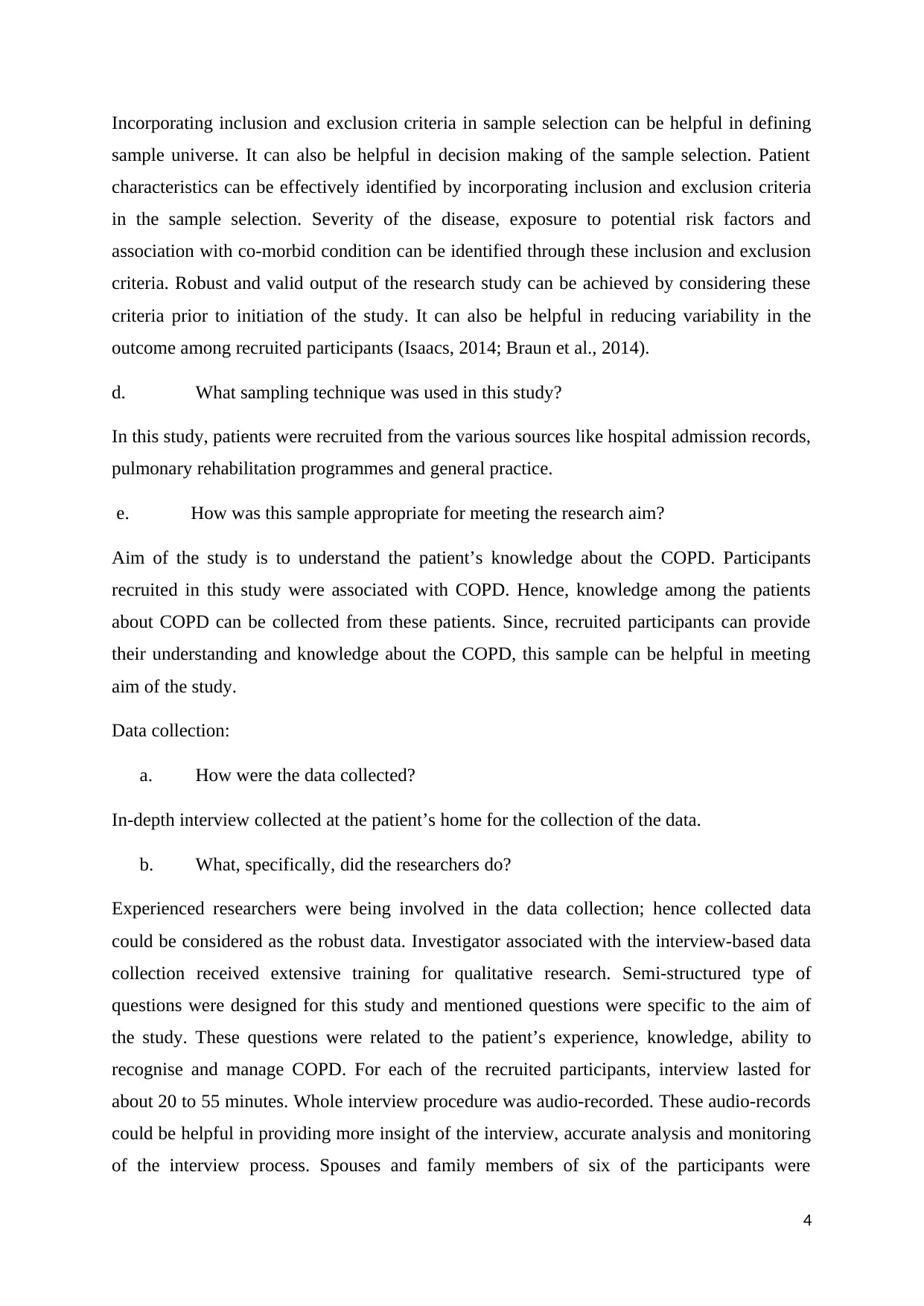
Incorporating inclusion and exclusion criteria in sample selection can be helpful in defining
sample universe. It can also be helpful in decision making of the sample selection. Patient
characteristics can be effectively identified by incorporating inclusion and exclusion criteria
in the sample selection. Severity of the disease, exposure to potential risk factors and
association with co-morbid condition can be identified through these inclusion and exclusion
criteria. Robust and valid output of the research study can be achieved by considering these
criteria prior to initiation of the study. It can also be helpful in reducing variability in the
outcome among recruited participants (Isaacs, 2014; Braun et al., 2014).
d. What sampling technique was used in this study?
In this study, patients were recruited from the various sources like hospital admission records,
pulmonary rehabilitation programmes and general practice.
e. How was this sample appropriate for meeting the research aim?
Aim of the study is to understand the patient’s knowledge about the COPD. Participants
recruited in this study were associated with COPD. Hence, knowledge among the patients
about COPD can be collected from these patients. Since, recruited participants can provide
their understanding and knowledge about the COPD, this sample can be helpful in meeting
aim of the study.
Data collection:
a. How were the data collected?
In-depth interview collected at the patient’s home for the collection of the data.
b. What, specifically, did the researchers do?
Experienced researchers were being involved in the data collection; hence collected data
could be considered as the robust data. Investigator associated with the interview-based data
collection received extensive training for qualitative research. Semi-structured type of
questions were designed for this study and mentioned questions were specific to the aim of
the study. These questions were related to the patient’s experience, knowledge, ability to
recognise and manage COPD. For each of the recruited participants, interview lasted for
about 20 to 55 minutes. Whole interview procedure was audio-recorded. These audio-records
could be helpful in providing more insight of the interview, accurate analysis and monitoring
of the interview process. Spouses and family members of six of the participants were
4
sample universe. It can also be helpful in decision making of the sample selection. Patient
characteristics can be effectively identified by incorporating inclusion and exclusion criteria
in the sample selection. Severity of the disease, exposure to potential risk factors and
association with co-morbid condition can be identified through these inclusion and exclusion
criteria. Robust and valid output of the research study can be achieved by considering these
criteria prior to initiation of the study. It can also be helpful in reducing variability in the
outcome among recruited participants (Isaacs, 2014; Braun et al., 2014).
d. What sampling technique was used in this study?
In this study, patients were recruited from the various sources like hospital admission records,
pulmonary rehabilitation programmes and general practice.
e. How was this sample appropriate for meeting the research aim?
Aim of the study is to understand the patient’s knowledge about the COPD. Participants
recruited in this study were associated with COPD. Hence, knowledge among the patients
about COPD can be collected from these patients. Since, recruited participants can provide
their understanding and knowledge about the COPD, this sample can be helpful in meeting
aim of the study.
Data collection:
a. How were the data collected?
In-depth interview collected at the patient’s home for the collection of the data.
b. What, specifically, did the researchers do?
Experienced researchers were being involved in the data collection; hence collected data
could be considered as the robust data. Investigator associated with the interview-based data
collection received extensive training for qualitative research. Semi-structured type of
questions were designed for this study and mentioned questions were specific to the aim of
the study. These questions were related to the patient’s experience, knowledge, ability to
recognise and manage COPD. For each of the recruited participants, interview lasted for
about 20 to 55 minutes. Whole interview procedure was audio-recorded. These audio-records
could be helpful in providing more insight of the interview, accurate analysis and monitoring
of the interview process. Spouses and family members of six of the participants were
4
Paraphrase This Document
Need a fresh take? Get an instant paraphrase of this document with our AI Paraphraser
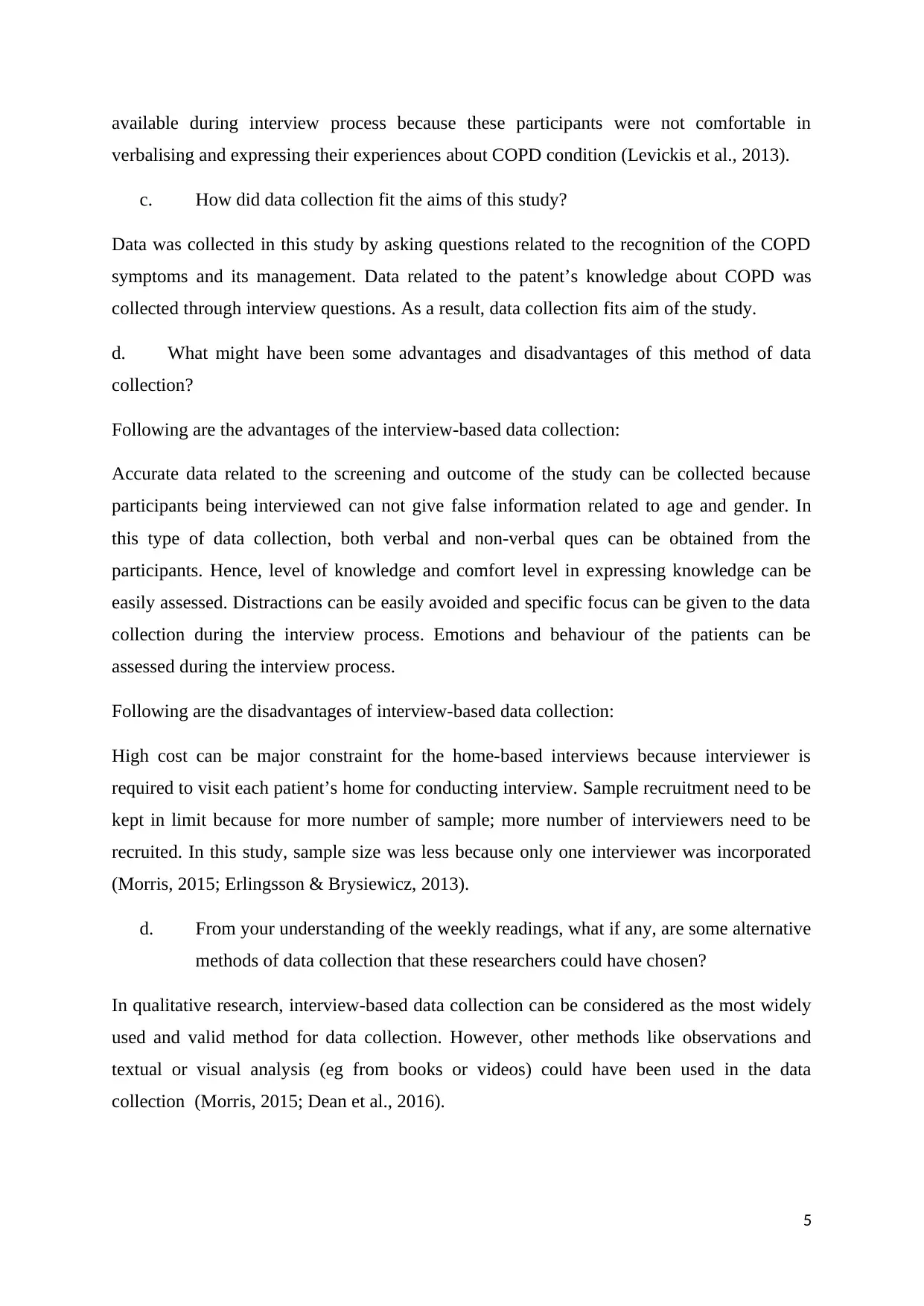
available during interview process because these participants were not comfortable in
verbalising and expressing their experiences about COPD condition (Levickis et al., 2013).
c. How did data collection fit the aims of this study?
Data was collected in this study by asking questions related to the recognition of the COPD
symptoms and its management. Data related to the patent’s knowledge about COPD was
collected through interview questions. As a result, data collection fits aim of the study.
d. What might have been some advantages and disadvantages of this method of data
collection?
Following are the advantages of the interview-based data collection:
Accurate data related to the screening and outcome of the study can be collected because
participants being interviewed can not give false information related to age and gender. In
this type of data collection, both verbal and non-verbal ques can be obtained from the
participants. Hence, level of knowledge and comfort level in expressing knowledge can be
easily assessed. Distractions can be easily avoided and specific focus can be given to the data
collection during the interview process. Emotions and behaviour of the patients can be
assessed during the interview process.
Following are the disadvantages of interview-based data collection:
High cost can be major constraint for the home-based interviews because interviewer is
required to visit each patient’s home for conducting interview. Sample recruitment need to be
kept in limit because for more number of sample; more number of interviewers need to be
recruited. In this study, sample size was less because only one interviewer was incorporated
(Morris, 2015; Erlingsson & Brysiewicz, 2013).
d. From your understanding of the weekly readings, what if any, are some alternative
methods of data collection that these researchers could have chosen?
In qualitative research, interview-based data collection can be considered as the most widely
used and valid method for data collection. However, other methods like observations and
textual or visual analysis (eg from books or videos) could have been used in the data
collection (Morris, 2015; Dean et al., 2016).
5
verbalising and expressing their experiences about COPD condition (Levickis et al., 2013).
c. How did data collection fit the aims of this study?
Data was collected in this study by asking questions related to the recognition of the COPD
symptoms and its management. Data related to the patent’s knowledge about COPD was
collected through interview questions. As a result, data collection fits aim of the study.
d. What might have been some advantages and disadvantages of this method of data
collection?
Following are the advantages of the interview-based data collection:
Accurate data related to the screening and outcome of the study can be collected because
participants being interviewed can not give false information related to age and gender. In
this type of data collection, both verbal and non-verbal ques can be obtained from the
participants. Hence, level of knowledge and comfort level in expressing knowledge can be
easily assessed. Distractions can be easily avoided and specific focus can be given to the data
collection during the interview process. Emotions and behaviour of the patients can be
assessed during the interview process.
Following are the disadvantages of interview-based data collection:
High cost can be major constraint for the home-based interviews because interviewer is
required to visit each patient’s home for conducting interview. Sample recruitment need to be
kept in limit because for more number of sample; more number of interviewers need to be
recruited. In this study, sample size was less because only one interviewer was incorporated
(Morris, 2015; Erlingsson & Brysiewicz, 2013).
d. From your understanding of the weekly readings, what if any, are some alternative
methods of data collection that these researchers could have chosen?
In qualitative research, interview-based data collection can be considered as the most widely
used and valid method for data collection. However, other methods like observations and
textual or visual analysis (eg from books or videos) could have been used in the data
collection (Morris, 2015; Dean et al., 2016).
5
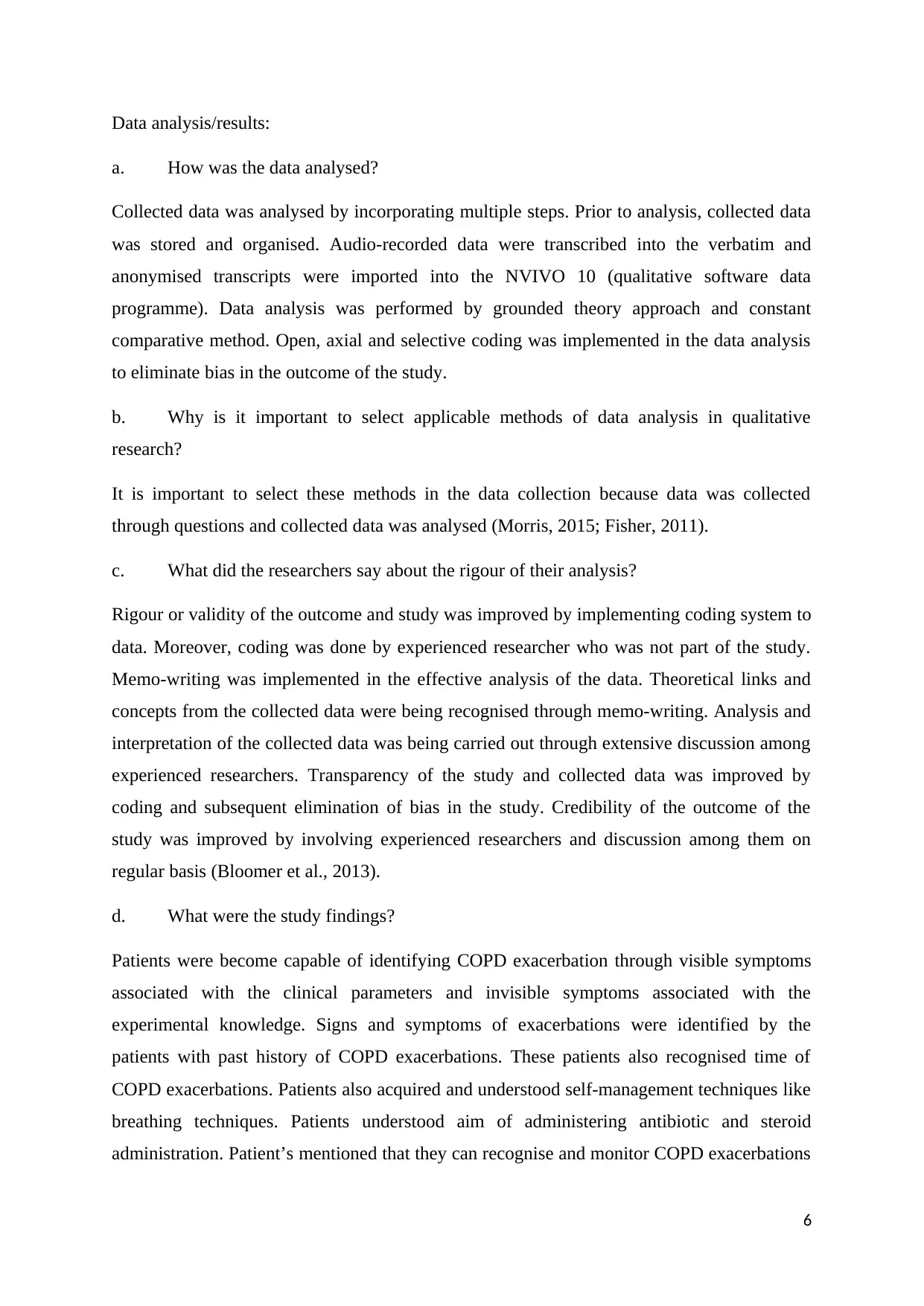
Data analysis/results:
a. How was the data analysed?
Collected data was analysed by incorporating multiple steps. Prior to analysis, collected data
was stored and organised. Audio-recorded data were transcribed into the verbatim and
anonymised transcripts were imported into the NVIVO 10 (qualitative software data
programme). Data analysis was performed by grounded theory approach and constant
comparative method. Open, axial and selective coding was implemented in the data analysis
to eliminate bias in the outcome of the study.
b. Why is it important to select applicable methods of data analysis in qualitative
research?
It is important to select these methods in the data collection because data was collected
through questions and collected data was analysed (Morris, 2015; Fisher, 2011).
c. What did the researchers say about the rigour of their analysis?
Rigour or validity of the outcome and study was improved by implementing coding system to
data. Moreover, coding was done by experienced researcher who was not part of the study.
Memo-writing was implemented in the effective analysis of the data. Theoretical links and
concepts from the collected data were being recognised through memo-writing. Analysis and
interpretation of the collected data was being carried out through extensive discussion among
experienced researchers. Transparency of the study and collected data was improved by
coding and subsequent elimination of bias in the study. Credibility of the outcome of the
study was improved by involving experienced researchers and discussion among them on
regular basis (Bloomer et al., 2013).
d. What were the study findings?
Patients were become capable of identifying COPD exacerbation through visible symptoms
associated with the clinical parameters and invisible symptoms associated with the
experimental knowledge. Signs and symptoms of exacerbations were identified by the
patients with past history of COPD exacerbations. These patients also recognised time of
COPD exacerbations. Patients also acquired and understood self-management techniques like
breathing techniques. Patients understood aim of administering antibiotic and steroid
administration. Patient’s mentioned that they can recognise and monitor COPD exacerbations
6
a. How was the data analysed?
Collected data was analysed by incorporating multiple steps. Prior to analysis, collected data
was stored and organised. Audio-recorded data were transcribed into the verbatim and
anonymised transcripts were imported into the NVIVO 10 (qualitative software data
programme). Data analysis was performed by grounded theory approach and constant
comparative method. Open, axial and selective coding was implemented in the data analysis
to eliminate bias in the outcome of the study.
b. Why is it important to select applicable methods of data analysis in qualitative
research?
It is important to select these methods in the data collection because data was collected
through questions and collected data was analysed (Morris, 2015; Fisher, 2011).
c. What did the researchers say about the rigour of their analysis?
Rigour or validity of the outcome and study was improved by implementing coding system to
data. Moreover, coding was done by experienced researcher who was not part of the study.
Memo-writing was implemented in the effective analysis of the data. Theoretical links and
concepts from the collected data were being recognised through memo-writing. Analysis and
interpretation of the collected data was being carried out through extensive discussion among
experienced researchers. Transparency of the study and collected data was improved by
coding and subsequent elimination of bias in the study. Credibility of the outcome of the
study was improved by involving experienced researchers and discussion among them on
regular basis (Bloomer et al., 2013).
d. What were the study findings?
Patients were become capable of identifying COPD exacerbation through visible symptoms
associated with the clinical parameters and invisible symptoms associated with the
experimental knowledge. Signs and symptoms of exacerbations were identified by the
patients with past history of COPD exacerbations. These patients also recognised time of
COPD exacerbations. Patients also acquired and understood self-management techniques like
breathing techniques. Patients understood aim of administering antibiotic and steroid
administration. Patient’s mentioned that they can recognise and monitor COPD exacerbations
6
⊘ This is a preview!⊘
Do you want full access?
Subscribe today to unlock all pages.

Trusted by 1+ million students worldwide

and ask for help from healthcare providers for receiving quality intervention. It can be helpful
in reducing further deterioration of the patient. Findings of this were in align with the aim of
the study because patient were able to recognise symptoms of the COPD.
e. Into which other settings can these findings be transferred
Findings from this qualitative research can be transferred to other long-term facilities like
diabetes and obesity care because in these healthcare facilities also visible and invisible
symptoms can be identified through experimental knowledge (Harreveld et al., 2016).
7
in reducing further deterioration of the patient. Findings of this were in align with the aim of
the study because patient were able to recognise symptoms of the COPD.
e. Into which other settings can these findings be transferred
Findings from this qualitative research can be transferred to other long-term facilities like
diabetes and obesity care because in these healthcare facilities also visible and invisible
symptoms can be identified through experimental knowledge (Harreveld et al., 2016).
7
Paraphrase This Document
Need a fresh take? Get an instant paraphrase of this document with our AI Paraphraser
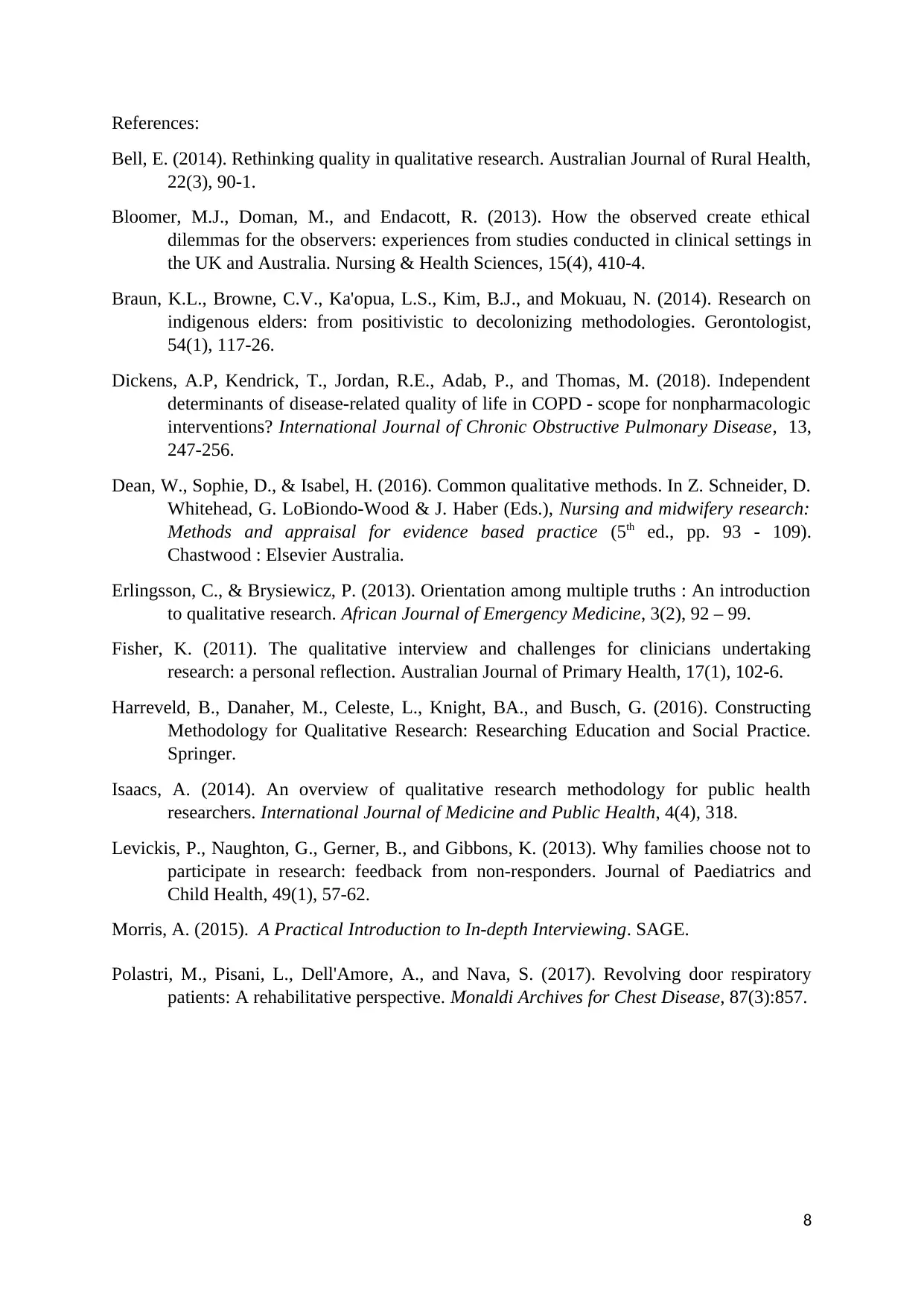
References:
Bell, E. (2014). Rethinking quality in qualitative research. Australian Journal of Rural Health,
22(3), 90-1.
Bloomer, M.J., Doman, M., and Endacott, R. (2013). How the observed create ethical
dilemmas for the observers: experiences from studies conducted in clinical settings in
the UK and Australia. Nursing & Health Sciences, 15(4), 410-4.
Braun, K.L., Browne, C.V., Ka'opua, L.S., Kim, B.J., and Mokuau, N. (2014). Research on
indigenous elders: from positivistic to decolonizing methodologies. Gerontologist,
54(1), 117-26.
Dickens, A.P, Kendrick, T., Jordan, R.E., Adab, P., and Thomas, M. (2018). Independent
determinants of disease-related quality of life in COPD - scope for nonpharmacologic
interventions? International Journal of Chronic Obstructive Pulmonary Disease, 13,
247-256.
Dean, W., Sophie, D., & Isabel, H. (2016). Common qualitative methods. In Z. Schneider, D.
Whitehead, G. LoBiondo-Wood & J. Haber (Eds.), Nursing and midwifery research:
Methods and appraisal for evidence based practice (5th ed., pp. 93 - 109).
Chastwood : Elsevier Australia.
Erlingsson, C., & Brysiewicz, P. (2013). Orientation among multiple truths : An introduction
to qualitative research. African Journal of Emergency Medicine, 3(2), 92 – 99.
Fisher, K. (2011). The qualitative interview and challenges for clinicians undertaking
research: a personal reflection. Australian Journal of Primary Health, 17(1), 102-6.
Harreveld, B., Danaher, M., Celeste, L., Knight, BA., and Busch, G. (2016). Constructing
Methodology for Qualitative Research: Researching Education and Social Practice.
Springer.
Isaacs, A. (2014). An overview of qualitative research methodology for public health
researchers. International Journal of Medicine and Public Health, 4(4), 318.
Levickis, P., Naughton, G., Gerner, B., and Gibbons, K. (2013). Why families choose not to
participate in research: feedback from non-responders. Journal of Paediatrics and
Child Health, 49(1), 57-62.
Morris, A. (2015). A Practical Introduction to In-depth Interviewing. SAGE.
Polastri, M., Pisani, L., Dell'Amore, A., and Nava, S. (2017). Revolving door respiratory
patients: A rehabilitative perspective. Monaldi Archives for Chest Disease, 87(3):857.
8
Bell, E. (2014). Rethinking quality in qualitative research. Australian Journal of Rural Health,
22(3), 90-1.
Bloomer, M.J., Doman, M., and Endacott, R. (2013). How the observed create ethical
dilemmas for the observers: experiences from studies conducted in clinical settings in
the UK and Australia. Nursing & Health Sciences, 15(4), 410-4.
Braun, K.L., Browne, C.V., Ka'opua, L.S., Kim, B.J., and Mokuau, N. (2014). Research on
indigenous elders: from positivistic to decolonizing methodologies. Gerontologist,
54(1), 117-26.
Dickens, A.P, Kendrick, T., Jordan, R.E., Adab, P., and Thomas, M. (2018). Independent
determinants of disease-related quality of life in COPD - scope for nonpharmacologic
interventions? International Journal of Chronic Obstructive Pulmonary Disease, 13,
247-256.
Dean, W., Sophie, D., & Isabel, H. (2016). Common qualitative methods. In Z. Schneider, D.
Whitehead, G. LoBiondo-Wood & J. Haber (Eds.), Nursing and midwifery research:
Methods and appraisal for evidence based practice (5th ed., pp. 93 - 109).
Chastwood : Elsevier Australia.
Erlingsson, C., & Brysiewicz, P. (2013). Orientation among multiple truths : An introduction
to qualitative research. African Journal of Emergency Medicine, 3(2), 92 – 99.
Fisher, K. (2011). The qualitative interview and challenges for clinicians undertaking
research: a personal reflection. Australian Journal of Primary Health, 17(1), 102-6.
Harreveld, B., Danaher, M., Celeste, L., Knight, BA., and Busch, G. (2016). Constructing
Methodology for Qualitative Research: Researching Education and Social Practice.
Springer.
Isaacs, A. (2014). An overview of qualitative research methodology for public health
researchers. International Journal of Medicine and Public Health, 4(4), 318.
Levickis, P., Naughton, G., Gerner, B., and Gibbons, K. (2013). Why families choose not to
participate in research: feedback from non-responders. Journal of Paediatrics and
Child Health, 49(1), 57-62.
Morris, A. (2015). A Practical Introduction to In-depth Interviewing. SAGE.
Polastri, M., Pisani, L., Dell'Amore, A., and Nava, S. (2017). Revolving door respiratory
patients: A rehabilitative perspective. Monaldi Archives for Chest Disease, 87(3):857.
8

9
⊘ This is a preview!⊘
Do you want full access?
Subscribe today to unlock all pages.

Trusted by 1+ million students worldwide
1 out of 9
Related Documents
Your All-in-One AI-Powered Toolkit for Academic Success.
+13062052269
info@desklib.com
Available 24*7 on WhatsApp / Email
![[object Object]](/_next/static/media/star-bottom.7253800d.svg)
Unlock your academic potential
Copyright © 2020–2025 A2Z Services. All Rights Reserved. Developed and managed by ZUCOL.




